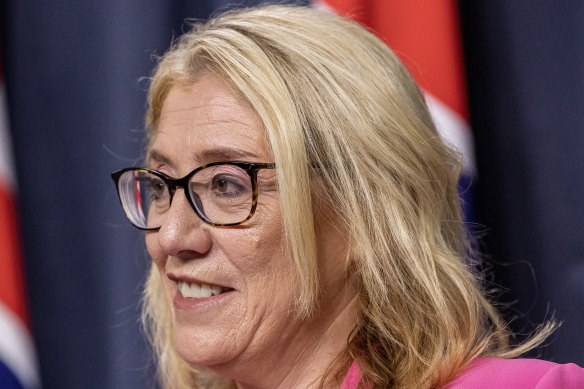Western Australia’s budget surplus for 2023-24 is expected to hit $3.7 billion, according to the mid-year review revealed by Treasurer Rita Saffioti on Tuesday.
This is up from the $3.3 billion operating surplus predicted in the May state budget, while the cash surplus – the money left over after operating expenses and infrastructure spending are accounted for – is expected to be $570 million.

Treasurer Rita Saffioti.Credit: Colin Murty
Debt is predicted to drop $2.2 billion to $27.1 billion, but it is still set for steep rises over the forward estimates to $38 billion by 2026-27.
Saffioti said the mid-year review showed her government delivered strong and sustainable financial results.
She said the government would deliver unbroken operating surpluses and record investment in infrastructure for the state’s future, while continuing to pay down debt.
“The mid-year review also highlights the continued strength of the WA economy despite volatility in the global economy, with a record number of Western Australians employed, strong business investment and resilient household consumption,” she said.
Despite the strong state of the books, the government has attracted criticism for not doing enough to support families feeling the impacts of inflation and cost of living increases.
The improved surplus has been driven mostly by a $3 billion uptick in iron ore royalties, but those gains were offset by ramped-up spending on infrastructure and spot fires in problem areas including health, housing, youth justice and family and domestic violence.
Saffioti also revealed Metronet costs continued to blow out, with another $700 million set aside over the forward estimates to deal with increases in material and labour. This is on top of a $1.2 billion blowout in the May budget.
Iron ore continues to be the government’s most important source of revenue.
In the May budget, the state estimated that the average iron ore price this financial year would be US$74.10 per tonne, and about 865 million tonnes of iron ore would be exported.
In Tuesday’s mid-year review, this was revised to US$104 a tonne.
The budget says for every US$1 per tonne increase above the estimated price of iron ore the state receives $89.8 million in royalties, meaning WA’s coffers are $3 billion better off than predicted in May.
While iron ore royalties exploded, a softer lithium price shaved $247 million off the expected royalties from that commodity.
The mid-year review also reveals the WA economy was weathering interest rate rises and global pressures, with state final demand now forecast to grow by 4.5 per cent in 2023-24 rather than the 3 per cent previously predicted.
The state’s hot economy resulted in more than $1 billion in extra taxes with payroll tax revenue up $493 million, home sales taxes up $368 million and vehicle licence duties up $162 million.
Despite the iron ore and tax boon, total government revenue is only up $2.26 billion to $45.5 billion thanks to some accounting magic that will see government trading enterprises keep $1.2 billion in revenue on their books rather than the state’s.
A $1 billion NDIS Commonwealth funding grant payment being delayed to next year has also impacted the bottom line by about $324 million despite an increase in federal funding like GST payments and transport payments.
The $1.8 billion growth in expenses has also eroded the surplus.
Opposition treasury spokesman Steve Thomas accused the government of hiding the true size of its surpluses by purposely under-representing iron ore price predictions and keeping money such as government trading enterprise dividends off the books.
He said the government was not doing enough to help families dealing with cost-of-living pressures.
“Handing out some money around electricity payments is not enough,” he said.
“This government is rich enough to make permanent changes to its economic structure, it could look at freezing fees and charges, it could look at reducing tax take, it could take its hand out of people’s pockets and business’ pockets.
“It could look at stamp duty, it could look at payroll tax, it’s doing none of those things. It’s simply taking more and more money and hiding it as long as it can and not looking after the people of this state.”
Saffioti said the government understood there were enormous challenges facing WA families and pointed to initiatives like lower transport costs, rent relief funding and electricity rebates as examples of her government addressing the cost-of-living crisis.
“We want to work with them to ensure that they can continue to meet the costs of running a family, but also ensuring that they’ve got opportunities for themselves and their children to get strong jobs in WA,” she said.
Saffioti denied that the extra spending on infrastructure as well as increases in public sector wages flagged on Monday would not add to an already high inflation environment that was struggling to house an increasing population.
She said there was capacity opening for future major infrastructure projects and the construction price index was stabilising.
“So we do believe this capacity in infrastructure revision going forward,” she said.
Start the day with a summary of the day’s most important and interesting stories, analysis and insights. Sign up for our Morning Edition newsletter.